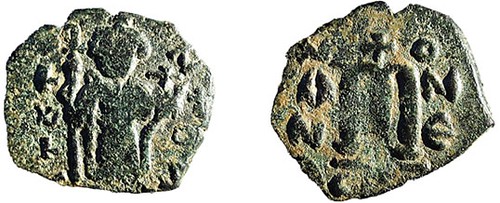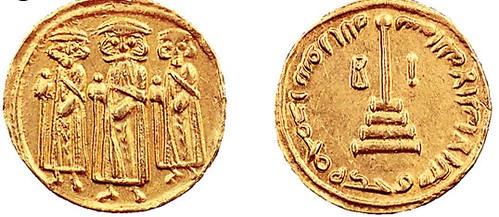
PREV ARTICLE
NEXT ARTICLE
FULL ISSUE
PREV FULL ISSUE
COINS OF TWO REALMS: THE ARAB COIN SYSTEM
Dick Hanscom forwarded this article on the Arab coin system by Clive Foss which appeared in the May/June 2015 issue of
AramcoWorld. Here's a short excerpt with a few images. Be sure to read the complete article online. -Editor
During the lifetime of Muhammad, Arabia did not issue its own coins, and coins are rarely mentioned in the Qur’an. For commerce, gold coins from the Byzantine Empire and silver ones from Persia were circulating, but they were used as bullion by weight rather than as coins with a fixed and often arbitrary value. When the Arabs expanded into the Near East in the middle of the seventh century, however, they came into close contact with societies that had issued coins for centuries. The Byzantines, who ruled what is now Turkey, Syria, Palestine and Egypt, produced gold and copper coins while the Persian Sassanids, who dominated today’s Iran and much of Iraq and Afghanistan, relied largely on silver. In all cases, their coins bore an image of the ruler and an indication of religion: crosses for the Byzantine Christians and fire altars for the Persian Zoroastrians. The most common types of coins in the Byzantine realms were copper; the largest was somewhat larger than a us quarter or one Euro, and it carried an “M”, the Greek number for a denomination of 40 nummi. The Persian realms used larger, thinner silver dirhams, a word derived from the Greek drachma. The Arabs rapidly adapted to this system by striking copper coins in Syria, Palestine and Egypt as well as silver ones in Iraq and Iran. While all types showed continuity with the local traditions, the issues in Syria were the most varied, while those of the Sassanid territories conformed most closely to existing standards. All offer surprises and insights into the situation in the Near East during the early period of Arab rule. 
The imperial figure has crosses in his hands and on his crown 
On others, however, the crosses were removed. 
These new gold coins, with their Islamic inscriptions in Arabic, caused an international crisis. Because of a treaty that followed an earlier defeat, ‘Abd al-Malik had been paying tribute to the Byzantines. When, in 692, he tried to pay it with the new coins, Emperor Justinian ii (r. 669-711 ce) refused them because the coins were of a type never seen before. Refusal of the tribute broke the treaty, and war followed. To read the complete article, see:
THE BOOK BAZARREWayne Homren, Editor The Numismatic Bibliomania Society is a non-profit organization promoting numismatic literature. See our web site at coinbooks.org. To submit items for publication in The E-Sylum, write to the Editor at this address: whomren@gmail.com To subscribe go to: https://my.binhost.com/lists/listinfo/esylum All Rights Reserved. NBS Home Page Contact the NBS webmaster 
|